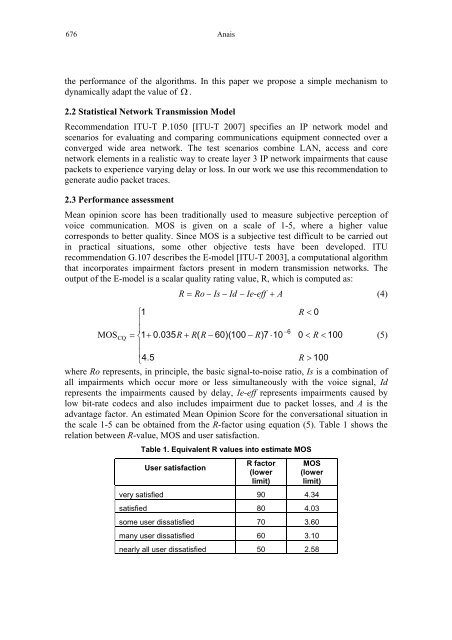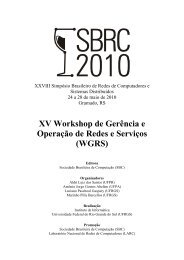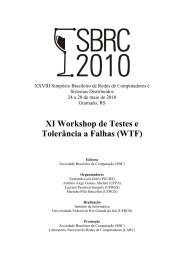Classical Playout Buffer Algorithm Revisited
Classical Playout Buffer Algorithm Revisited
Classical Playout Buffer Algorithm Revisited
Create successful ePaper yourself
Turn your PDF publications into a flip-book with our unique Google optimized e-Paper software.
676 Anais<br />
the performance of the algorithms. In this paper we propose a simple mechanism to<br />
dynamically adapt the value of Ω .<br />
2.2 Statistical Network Transmission Model<br />
Recommendation ITU-T P.1050 [ITU-T 2007] specifies an IP network model and<br />
scenarios for evaluating and comparing communications equipment connected over a<br />
converged wide area network. The test scenarios combine LAN, access and core<br />
network elements in a realistic way to create layer 3 IP network impairments that cause<br />
packets to experience varying delay or loss. In our work we use this recommendation to<br />
generate audio packet traces.<br />
2.3 Performance assessment<br />
Mean opinion score has been traditionally used to measure subjective perception of<br />
voice communication. MOS is given on a scale of 1-5, where a higher value<br />
corresponds to better quality. Since MOS is a subjective test difficult to be carried out<br />
in practical situations, some other objective tests have been developed. ITU<br />
recommendation G.107 describes the E-model [ITU-T 2003], a computational algorithm<br />
that incorporates impairment factors present in modern transmission networks. The<br />
output of the E-model is a scalar quality rating value, R, which is computed as:<br />
R = Ro − Is − Id − Ie-eff + A<br />
(4)<br />
⎧1<br />
R < 0<br />
⎪<br />
⎪<br />
−6<br />
MOS CQ = ⎨1<br />
+ 0.035R<br />
+ R(<br />
R − 60)(100 − R)7<br />
⋅10<br />
0 < R < 100 (5)<br />
⎪<br />
⎪<br />
⎩4.5<br />
R > 100<br />
where Ro represents, in principle, the basic signal-to-noise ratio, Is is a combination of<br />
all impairments which occur more or less simultaneously with the voice signal, Id<br />
represents the impairments caused by delay, Ie-eff represents impairments caused by<br />
low bit-rate codecs and also includes impairment due to packet losses, and A is the<br />
advantage factor. An estimated Mean Opinion Score for the conversational situation in<br />
the scale 1-5 can be obtained from the R-factor using equation (5). Table 1 shows the<br />
relation between R-value, MOS and user satisfaction.<br />
Table 1. Equivalent R values into estimate MOS<br />
User satisfaction<br />
R factor<br />
(lower<br />
limit)<br />
MOS<br />
(lower<br />
limit)<br />
very satisfied 90 4.34<br />
satisfied 80 4.03<br />
some user dissatisfied 70 3.60<br />
many user dissatisfied 60 3.10<br />
nearly all user dissatisfied 50 2.58







